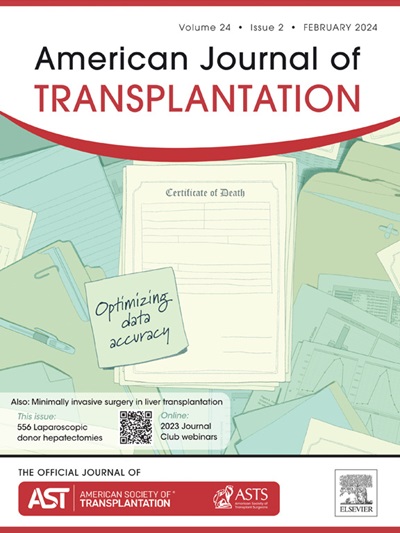Antigen quantity is responsible for the discrepancy between phenotype and single antigen beads for the detection of human leukocyte antigen DQ antibody: Potential clinical implications
IF 8.2
2区 医学
Q1 SURGERY
引用次数: 0
Abstract
De novo donor-specific human leukocyte antigen DQ antibodies detected by single antigen beads (SAB) are significantly associated with chronic antibody-mediated rejection and lower overall graft survival. However, some DQ antibodies identified by SAB cannot be confirmed by phenotype antigen-bearing class II bead assays, raising concerns about the validity of SAB data. The inability to detect these antibodies on phenotype antigen beads could be due to a lower quantity of DQ antigens present on the surface of the beads compared to DR antigens. In this study, we demonstrate that DQ-enriched phenotype antigens exhibit the same reactivity with DQ antibodies detected by SAB, confirming the hypothesis that it is antigen quantity and not structural differences that account for discrepancies in human leukocyte antigen DQ antibody detection between phenotype antigen beads and SAB. In addition, we show that the expression of individual DQ antigens in heterozygous cells can vary significantly, further confounding correlation studies. Therefore, the common clinical practice of using the phenotype antigen beads as a screening assay, reflexing to SAB testing only when positive, may inadvertently fail to detect DQ-specific antibodies. Such errors could impact organ acceptance practices, immunosuppression treatment decisions, and/or the need for additional diagnostic testing to rule out antibody-mediated rejection.
抗原数量是导致表型与单抗原珠检测HLA-DQ抗体差异的原因:潜在的临床意义。
单抗原珠(SAB)检测的新供体特异性HLA-DQ抗体与慢性抗体介导的排斥反应和较低的总体移植物存活率显著相关。然而,一些由SAB鉴定的DQ抗体不能通过携带表型抗原的II类头测定来证实,这引起了对SAB数据有效性的担忧。无法在表型抗原珠上检测到这些抗体可能是由于与DR抗原相比,DQ抗原在珠表面的含量较低。在这项研究中,我们证明了富含DQ的表型抗原与SAB检测到的DQ抗体表现出相同的反应性,证实了抗原数量而不是结构差异导致表型抗原珠和SAB之间HLA DQ抗体检测差异的假设。此外,我们发现单个DQ抗原在杂合细胞中的表达可以显著变化,这进一步混淆了相关研究。因此,使用表型抗原珠作为筛选试验的常见临床实践,仅在SAB检测阳性时才反射,可能无意中无法检测到dq特异性抗体。这些错误可能会影响器官接受实践、免疫抑制治疗决策和/或需要额外的诊断测试来排除抗体介导的排斥反应。
本文章由计算机程序翻译,如有差异,请以英文原文为准。
求助全文
约1分钟内获得全文
求助全文
来源期刊
CiteScore
18.70
自引率
4.50%
发文量
346
审稿时长
26 days
期刊介绍:
The American Journal of Transplantation is a leading journal in the field of transplantation. It serves as a forum for debate and reassessment, an agent of change, and a major platform for promoting understanding, improving results, and advancing science. Published monthly, it provides an essential resource for researchers and clinicians worldwide.
The journal publishes original articles, case reports, invited reviews, letters to the editor, critical reviews, news features, consensus documents, and guidelines over 12 issues a year. It covers all major subject areas in transplantation, including thoracic (heart, lung), abdominal (kidney, liver, pancreas, islets), tissue and stem cell transplantation, organ and tissue donation and preservation, tissue injury, repair, inflammation, and aging, histocompatibility, drugs and pharmacology, graft survival, and prevention of graft dysfunction and failure. It also explores ethical and social issues in the field.

 求助内容:
求助内容: 应助结果提醒方式:
应助结果提醒方式:


